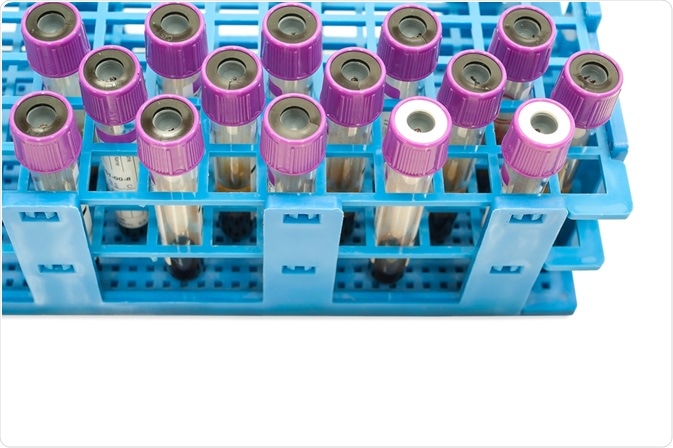Flow cytometry is an incredibly useful analytical tool that has revolutionized the way in which single-cell and particle characterization is performed. Despite its effectiveness, flow cytometry requires users to treat their samples with fluorescent labels that can occasionally destroy cells and/or particles of interest.
 Image Credits: Chansom Pantip / Shutterstock.com
Image Credits: Chansom Pantip / Shutterstock.com
An overview of flow cytometry
Flow cytometry is a widely used analytical method that detects and measures both the physical and chemical characteristics of a cell or other micro-scale biological population. In order to do this, either the forward/side scattering properties or the fluorescence emission intensity of the analytes are measured by a cytometer that is often coupled with several other devices, such as a photomultiplier (PMT), multiple-wavelength light source and spectroscopy.
These system requirements often lead flow cytometry systems to be bulky and complex to operate. In addition to the inherent challenges associated with the flow cytometry system, researchers must typically perform lengthy pretreatment steps that involve the use of expensive fluorescence labels, which can sometimes cause cell samples to be destroyed in the process.
Label-free flow cytometry systems
In an effort to overcome the limitations associated with flow cytometry systems, several label-free microfluidic flow cytometry systems have been investigated, of which include optical flow cytometry, impedance-based cytometry, photoacoustic cytometry, as well as a novel self-mixing interferometry technique.
Optical flow cytometry
Optical flow cytometry is one of the most commonly used non-intrusive cell interrogation methods. The widespread use of optical flow cytometry has inspired many researchers to integrate various techniques into this method, some of which include light-scattering imaging, reflectance confocal microscopy and diffraction phase microscopy, to name a few.
Impedance-based cytometry
As cells pass through the measurement volume of an impedance-based cytometry system, the impedance change that arises between the two microelectrodes embedded within the channel is measured. This impendence value can be used to reflect both the dielectric properties and internal components present within the analytes.
As compared to other flow cytometry techniques, impedance-based cytometry systems are often considered to be advantageous as a result of their ease of operation, self-contained layout and high level of integration that exists within their microelectrode channel.
Photoacoustic cytometry
As the analyte of interest absorbs a short laser pulse sequence, photon energy within the photoacoustic cytometry is transformed into heat. This heat generation subsequently creates ultrasonic acoustic waves as a result of the thermo-elastic effect, which will then pass through and ultrasound transducer that analyzes the properties of the analytes.
Recent studies on melanoma detection in the skin, red blood cell aggregates in vessels and cancer cells in bones have demonstrated the unique advantages associated with photoacoustic cytometry for in vivo analysis of tissues.
Self-mixing interferometry for label-free cell classification
Despite the availability of alternative label-free flow cytometry approaches, these systems remain limited due to expensive associated costs and complex operation. Self-mixing interferometry has therefore emerged as an ideal alternative as a result of its compact size, low-consumption and self-alignment properties.
Furthermore, self-mixing interferometry can be easily adapted to analyze both micro- and nanosized particles present within a wide range of microfluidic systems. The working principle behind self-mixing interferometry is based on the interaction between scattered light that re-enters the laser cavity after analyte particles flow through the laser beam volume and the original light present within the cavity.
At the same time that this interaction is being measured, the velocity of the analyte particles will determine the spectral shift within the frequency domain by the output power signal.
While traditional applications of self-mixing interferometry have been found in metrology, recent work has found the usefulness of this technique as a fluorescent label-free method for cell classification.
In this study, a novel optofluidic cytometry system comprised of a commercial 1310 nanometer (nm) distributed feedback (DFB) laser diode functioned as both the laser source and the sensor, as well as a homemade hydrodynamic channel. All microfluidic samples, of which included polystyrene sphere suspensions of human breast cancer and embryonic kidney cells, were directly injected into the homemade channel for analysis.
This novel system was found to provide a highly sensitive characterization of the purity, concentration and size of both tested biological cell populations. While more work must still be performed to improve the self-mixing interferometry system’s resolution capabilities, this study demonstrated a new and exciting approach for cell characterization that eliminates the need for fluorescent labeling.
Sources
Zhao, Y., Shen, X., Zhang, M., Yu, J., Li, J., Wang, X., et al. Self-Mixing Interferometry-Based Micro Flow Cytometry System for Label-Free Cells Classification. Applied Sciences 10(478). DOI:10.3390/app10020478.
Last Updated: Jun 17, 2020